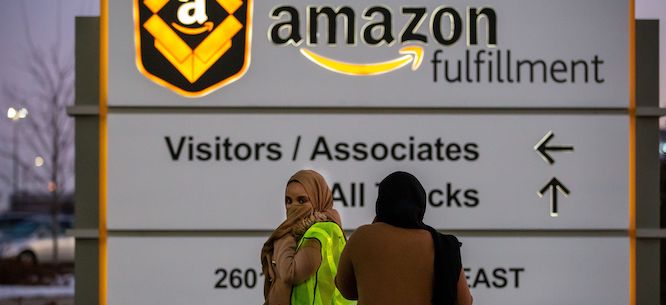Jeff Bezos Praises Amazon’s COVID-19 Response. Workers Tell Another Story.
Jeff Bezos Praises Amazon’s COVID-19 Response. Workers Tell Another Story.
In Shakopee, Minnesota, workers at the fulfillment center MSP1 organize walkouts over firings and coronavirus policies.

Last week, as Amazon co-founder Jeff Bezos was grilled by members of Congress on the e-commerce giant’s shady business maneuvers, he boasted that the company had made huge efforts in protecting workers from COVID-19.
But in Shakopee, Minnesota, workers at the gigantic fulfillment center MSP1, which employs about 1,000 people—many of them refugees of East African descent—are less than impressed with the corporation’s state-of-the-art system for safeguarding its workforce.
In late June, eighty-eight workers were reported to have been diagnosed with COVID-19, raising concerns that the company was not being transparent about the extent of the spread of the infection.
Will Stolz, a picker at Amazon who has helped organize for better safety conditions, said the number of COVID-19 cases “was a lot higher than most workers thought it was.” Workers were especially upset to learn the news in the wake of Amazon’s heavily criticized decision to rescind its relatively accommodating unpaid leave policy on May 1, which had enabled workers to opt to take unlimited unpaid time off for COVID-19-related health reasons. The announcement of the policy change in April prompted some workers to walk out in protest. Stolz said:
The idea was that if you were feeling sick, you could just go home in the middle of the day, and stay home. You don’t have to talk to anybody, you don’t have to worry, you’re not going to lose your job. . . . And they got rid of that at the end of April, right as the pandemic was getting worse, in my warehouse. And everybody knew it; we just didn’t know exactly how bad.
Amazon knew how bad. In public, the company claimed that the infection rates at its fulfillment centers were generally no worse than the rate in the surrounding communities. But as Bloomberg News reported in late June, an internal memo revealed that in mid-May the infection rate at MSP1 was roughly 1.7 percent, more than quadruple the rate in nearby Hennepin County. At the same time, workers claimed Amazon sent workers only vague notices about new infections, without giving exact numbers, giving many the impression that there were significantly fewer cases. (Nationwide, as of late June, labor advocates estimated there were some 1,500 cases in Amazon facilities, out of about half a million workers.)
Amazon’s opacity could have life-or-death consequences. “Without [reporting of] detailed information about just how bad the spread has gotten within our warehouse, or any of these Amazon warehouses,” Stolz said,
Workers don’t have the ability to make the kinds of risk calculations for [whether it’s] worth it for me to go into work, and get money to pay my bills, even if it means potentially exposing [others]. . . . With Amazon trying to downplay the extent of the spread, it doesn’t allow workers to make that kind of risk calculation for themselves, to keep them and their family safe and also with enough money to pay the bills.
Amazon spokesperson Jen Crowcroft said in a statement that Amazon “[spent] more than $800 million in the first half of the year on COVID-19 safety measures,” including personal protective equipment, testing workers, and extra sanitizing. Amazon also claims it keeps all employees informed about infections among coworkers and advises people to self-isolate as needed.
Stolz said he was glad that the management at MSP1 seemed to be taking infection control seriously in some ways, including regular temperature checks at the door, in-house testing, and mandatory mask-wearing. But as with the obfuscation of the actual infection rate, the safety practices have also made it harder for workers to understand the level of risk they are facing at work each day. Stolz said that the health and safety committee—an initiative that workers had successfully implemented last year in order to address extraordinarily high occupational injury rates—has been disbanded, apparently to comply with social distancing rules, despite workers needing a place to air safety concerns more than ever.
Stolz thought back to the start of the pandemic, when Amazon saw a rapid surge in demand, and workers were in the spotlight as they agitated for more comprehensive safety protections at work.
When the coronavirus first started happening, I saw labor-oriented writers saying, “This is a huge opportunity for workers. Frontline workers are needed now more than ever, they can flex their power, and this is your moment to seize.” . . . There’s some truth in that, but at the same time, it’s become a lot harder to communicate with other workers, with the social distancing that we have to do.
On the other hand, he noted that his fulfillment center has been part of a wave of protests at Amazon facilities around the country. In April dozens of workers at MSP1 walked out to protest the alleged retaliatory termination of a coworker. “So it just goes to show that even as we’re facing all these difficulties . . . people really do feel for each other, and want to support each other.”
Michelle Chen is a member of Dissent’s editorial board and co-host of its Belabored podcast.





